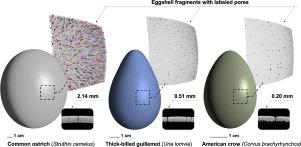推进鸟类蛋壳的x射线微计算机断层扫描图像处理:一种改进的多尺度三维图像配准度量和使用边缘关注神经网络的蛋壳孔隙分辨率增强分割。
IF 2.2
3区 工程技术
Q1 MICROSCOPY
引用次数: 0
摘要
鸟蛋的形状和大小各不相同,反映了不同的繁殖策略。蛋壳不仅保护卵内物,还调节对胚胎发育至关重要的气体和水蒸气交换。虽然许多研究已经探索了蛋壳的超微结构,但由于成像中分辨率和视场之间的权衡,人们对整个蛋壳上毛孔的分布知之甚少。为了克服这个问题,开发了一种神经网络,用于提高低分辨率3D层析数据的分辨率,同时执行体素标记。该模型使用自然历史博物馆收藏的鸵鸟、海鸠和乌鸦蛋壳的x射线微计算机断层扫描图像进行训练,使用逐步放大来创建低分辨率和高分辨率的训练集。采用基于局部灰度梯度的新度量验证了配准性能。边缘关注损失函数防止了对主导背景类(所有体素的95%)的偏差,确保了蛋壳(5%)和孔隙(0.1%)体素的准确标记。结果表明,除了边缘关注和类平衡之外,3D上下文保存和3D卷积对于外推亚体素特征至关重要。本文章由计算机程序翻译,如有差异,请以英文原文为准。

Advancing X-ray microcomputed tomography image processing of avian eggshells: An improved registration metric for multiscale 3D images and resolution-enhanced segmentation of eggshell pores using edge-attentive neural networks
Avian eggs exhibit a variety of shapes and sizes, reflecting different reproductive strategies. The eggshell not only protects the egg contents, but also regulates gas and water vapor exchange vital for embryonic development. While many studies have explored eggshell ultrastructure, the distribution of pores across the entire shell is less well understood because of a trade-off between resolution and field-of-view in imaging. To overcome this, a neural network was developed for resolution enhancement of low-resolution 3D tomographic data, while performing voxel-wise labeling. Trained on X-ray microcomputed tomography images of ostrich, guillemot and crow eggshells from a natural history museum collection, the model used stepwise magnification to create low- and high-resolution training sets. Registration performance was validated with a novel metric based on local grayscale gradients. An edge-attentive loss function prevented bias towards the dominant background class (95% of all voxels), ensuring accurate labeling of eggshell (5%) and pore (0.1%) voxels. The results indicate that besides edge-attention and class balancing, 3D context preservation and 3D convolution are of paramount importance for extrapolating subvoxel features.
求助全文
通过发布文献求助,成功后即可免费获取论文全文。
去求助
来源期刊

Micron
工程技术-显微镜技术
CiteScore
4.30
自引率
4.20%
发文量
100
审稿时长
31 days
期刊介绍:
Micron is an interdisciplinary forum for all work that involves new applications of microscopy or where advanced microscopy plays a central role. The journal will publish on the design, methods, application, practice or theory of microscopy and microanalysis, including reports on optical, electron-beam, X-ray microtomography, and scanning-probe systems. It also aims at the regular publication of review papers, short communications, as well as thematic issues on contemporary developments in microscopy and microanalysis. The journal embraces original research in which microscopy has contributed significantly to knowledge in biology, life science, nanoscience and nanotechnology, materials science and engineering.
 求助内容:
求助内容: 应助结果提醒方式:
应助结果提醒方式:


